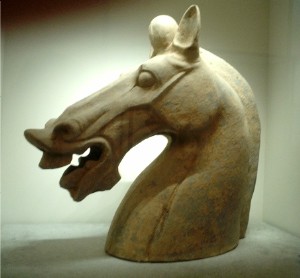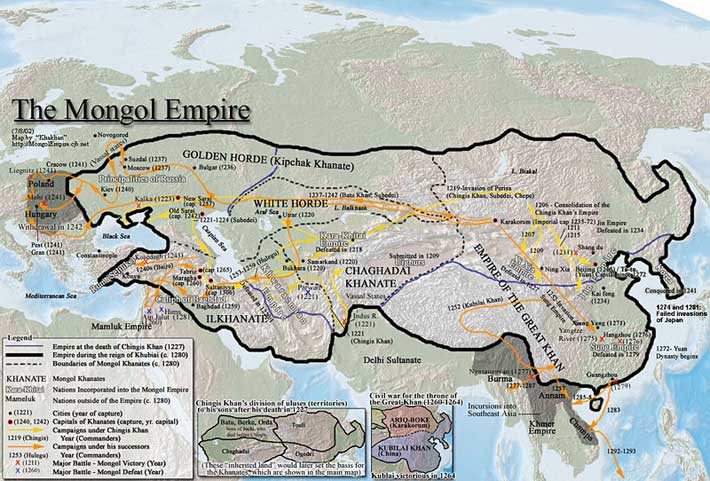

If you recall from the previous lesson on China, various dynasties were following each other with slightly different areas under their control. The last lesson ended with the fall of the Qin dynasty after the death of Shi Huang Di (he of the terra cotta army) in 206 BC. The successors, the Han, were to rule China all the way to 184 AD. By that point in time, other important states were developing in central and east Asia, and a major religious development, the birth of Buddha, had already occurred.
As noted earlier, the islands of what is now Japan were first occupied by foragers some 30,000 years ago. By 10,000 BC these original inhabitants developed the culture known as Jomon, already briefly discussed in the last unit as the makers of some of the earliest pottery in the world (even though these early Jomon people were foragers.) By the time Mesopotamia was building its first cities, Jomon people had adopted horticulture from neighboring China. At about 300 BC, however, a new culture and a new people invaded Japan from the Chinese mainland and Korean peninsula. They brought with them sophisticated rice agriculture, many domesticated animals, bronze and iron, a new religion (which would eventually develop into Shinto), a new language, and a chiefdom form of social organization. These people are archaeologically known as the Yayoi, the ancestors of most of the people of modern Japan.
Most archaeological evidence indicates that the indigenous Jomon people were almost totally displaced by the Yayoi, and pushed to the north (where they became the ancestors of the modern Ainu), though Japanese history often tries to stress that the indigenous people assimilated the Yayoi. [The reason for this is that if the Jomon people assimilated the Yayoi, than the ancestors of modern Japanese were the first inhabitants of Japan. MtDNA evidence indicates that most modern Japanese share mtDNA sequences with modern-day Koreans. However, some modern Japanese share mtDNA with the Ainu, indicating a significant genetic mixture of Yayoi and Jomon peoples.] By 500 AD a new wave of influence from China, via the Korean peninsula, had spurred the development of the earliest agrarian state in Japan, the Yamato. It is at that point that the long and continuous history of Japan truly begins.
India had been an area of small states (from the time of the Indus Valley/Harrapan state), until one expanded and conquered the others, establishing the Mauryan Empire in 322 BC. Under a king named Chandragupta Maurya, the Mauryans expanded, controlling not only most of what is now India, but also Pakistan and Afghanistan (where they conquered the small states left from the disintegration of the Empire of Alexander the Great), as well as Bangladesh.

Mauryan Empire at its Height in 265 BC[Wikimedia Commons, Public Domain]
It was under the rule of the greatest Mauryan emperor, Ashoka, that Buddhism became an important religion in India, and was spread to other areas. [The historical Buddha was born Siddhartha Gotama ca. 623 BC in the border area of Nepal and India.] Ashoka himself became a Buddhist (though without rejecting his religion of Hinduism) and sent Buddhist missions into western Asia, Afghanistan, Greece and southeast Asia. He is also credited with building numerous monasteries and Buddhist schools, as well as publishing Buddhist literature throughout his empire. After the fall of the Mauryan Empire, India became an area of smaller, competing states, until again united ca. 1500 AD under the Muslim Mughal Empire.
China under the Han Dynasty (206 BC-184 AD) returned to new forms of Legalism and Confucianism, and the dynasty attempted to unite all of China. Its population continued to grow; by approximately 1 AD, China, in the world's first census, had a population of 57.7 million people. The borders of China were expanded into present-day Korea and Vietnam, and deep into the Gobi Desert to the northwest. Some 2 million Chinese were transported into the northwestern region to colonize the area, and new contact via trade was made with the people of central Asia. In particular, the Chinese learned of the large horses ("heavenly horses") in the small state of Dayuan in what is now Tajikistan. Dayuan was described as a mostly urban state, manufacturing wine but also semi-pastoral in nature. It is probable that some of the soldiers left by Alexander the Great survived in the area after the collapse of Alexander's Empire.

Heavenly Horse from Han Dynasty [Public Domain]
After several attempts to trade for large numbers of these horses, China attacked Dayuan with an army that at one time numbered 100,000 men; China eventually managed to acquire over 3,000 horses, useful to the dynasty in uniting China and eliminating rivals for power. In the process China opened what came to be called the Silk Roads, different trade routes on land (and ultimately the ocean) which were to link Europe, Asia and to some extent Africa in an extensive trade network. The use of iron tools, ox-drawn plows, and larger irrigation systems also became common during this period, and work on the Great Wall continued. By 100 BC, Buddhism was entering China via the Silk Roads.
Silk Roads across Asia into Africa and Europe (Red Lines) plus Ocean Trade Routes (Blue Lines) [Public Domain]
After the Han Dynasty, China went through a period of disunity and civil war, to be again briefly united by the Chin Dynasty ca. 265-317 AD. While various dynasties continued to compete, it was not until the successful invasion of the Mongols that most of China was again reunited--as part of the Mongol Empire under Genghis Khan.
Genghis Khan (also spelled Chinggis Khan) was born in what is now Mongolia, probably around 1165 AD. Often cited as a military and administrative genius, he created a powerful chiefdom/state out of the pastoral tribes of the area, uniting Mongolia by 1207. Eventually, his sons and grandsons helped create the biggest land empire in history, extending from the coast of eastern Asia to eastern Europe. It included all of China, Mongolia, Korea, Persia (Iran), Pakistan, Afghanistan, Turkistan, Uzbekistan, Tajikistan, Armenia, parts of Russia, India, Hungary and at times Burma, Vietnam,Thailand, and Cambodia, as well as other modern countries. Many of these areas were of course occupied by strong political states, such as the Angkor (AD 802-1431) in Cambodia, who in this case were not incorporated into the Mongol Empire (see pp. 488-491 in text.) The map below shows the Mongol Empire's greatest extent, with some of the divisions of the Empire during the time of Genghis Khan's sons and grandsons.

DARK LINE SHOWS GREATEST EXTENT OF MONGOL EMPIRE (CA 1280) WITH DARKER AREAS ILLUSTRATING CAMPAIGNS/PARTIAL CONTROL OF PORTIONS OF EUROPE/SOUTHEAST ASIA [PUBLIC DOMAIN]
Much of the conquest of so many cultures and states was motivated by the desire for territory and wealth, though some was retaliatory in payment for earlier attacks on the Mongols. The Mongols earned a reputation as savage conquerors, often destroying the populations of entire cities, but they also increased trade throughout Asia and into Europe and Africa. In the attempt to rule an ethnically and culturally diverse empire, Genghis Khan established what could be called a meritocracy, drawing local administrators from some of the best qualified individuals. (Of course the top administrators were always Mongols, the heirs of Genghis.) Unlike many other conquerors before and since, the Mongols did not try to change anyone's religious beliefs, and tolerated various tribal religions as well as Buddhism, Islam, and Christianity, among others. In addition, Genghis helped introduce a writing system to Mongolia.
The genetic imprint of Genghis Khan may still be found across Asia and Europe. The Y chromosome in humans is somewhat analogous to mitochondria in tracing human ancestry. Like mtDNA, the Y chromosome does not for the most part exchange genetic material during cell division; it is handed down virtually intact (except for newly arisen mutations) form father to son. Therefore, a man's Y chromosome is identical to that of his father, his father's father, and his father's father's father, and extending backwards in time, with again, the exception of any new mutations. Studies of the Y chromosome from modern humans have discovered a Y chromosome that is found across central Asia and into Europe east of the Caspian Sea, from Korea all the way to the Czech Republic in Europe. The indications from associated mutations are that this particular Y chromosome, shared by close to 20 million men in Eurasia, indicates that these men had a common, and prolific, ancestor about 1100 AD. The most likely common ancestor is Genghis Khan, who left many sons and grandsons throughout the area of conquest in the map above. (from Adam's Curse, by Bryan Sykes, 2004)

Genghis Khan (1165-1227 AD) [Chinese painting on silk. Public Domain]
Kublai Khan, a grandson of Genghis Khan, completed the conquest of China in 1279, establishing the Yuan Dynasty. Though few Chinese were permitted to hold high office under the Yuan Dynasty, the Mongols in China became increasingly assimilated into Chinese culture. It was during Kublai' s reign that the Italian Marco Polo visited Beijing in 1275, meeting the Khan at his newly established capital. While Marco Polo was not the first European to visit the Mongols, he traveled further east than any of his predecessors, spent more time in China, and on his return stimulated many Europeans to find a quicker route to eastern Asia than the land and water Silk Roads (see map above). It was the desire for a quicker route to China and eastern Asia that ultimately led Europeans around Africa and across the Atlantic to the Americas--with disastrous consequences for the people of both Africa and the Americas.
By the time of Kublai Khan's death in 1294, the vast Mongol Empire was beginning to break down. The new dynasty that became established in China, the Ming Dynasty (1368-1644 AD), strengthened both the military and the Great Wall, rebuilding, repairing and extending this barrier to prevent any more incursions from the Mongols. In the name of extending trade, China under the Ming Dynasty also built large ships, launching a series of naval explorations that reached the east coast of Africa. China for a while was building the largest ships in the world, capable of carrying 500 men. However, after the last of these voyages in 1433, China abandoned the effort, destroyed records of these expeditions, and restricted ship-building to small vessels. If China had not stopped its naval explorations, without question they would have rounded Africa and sailed north into the Mediterranean, and possibly even tried to get to Europe by sailing east; it is interesting to speculate how such voyages might have changed history. As it was, Bartolomeu Diaz, sailing for Portugal, rounded the southern tip of Africa in 1490, and his countryman Vasco de Gama headed an expedition that reached India in 1498. By that time, of course, Columbus, sailing for Spain, had reached the Americas.
In western Asia, Timur or Tamerlane, a one-time vassal of the Mongols, began in 1364 to reconsolidate much of the empire of the Mongols. In a series of campaigns every bit as bloody as that of the Mongols (it has been estimated that Timur slaughtered as many as 17 million people--90,000 were reported to have been beheaded in Baghdad alone), he ultimately controlled much of southwest and central Asia. He also spread Islam, forcing people to convert or be killed. His death occurred in 1405 while he was attempting to attack Ming Dynasty China, and his empire did not long survive.